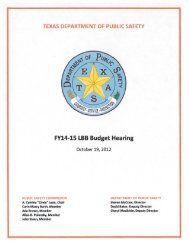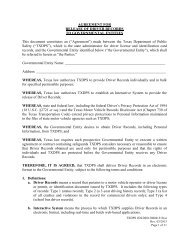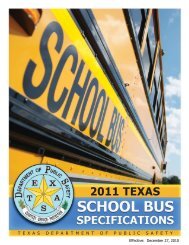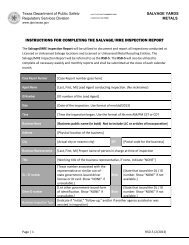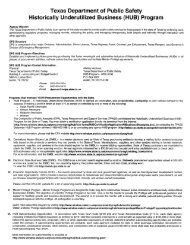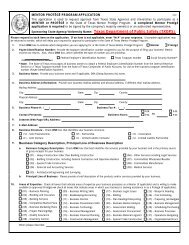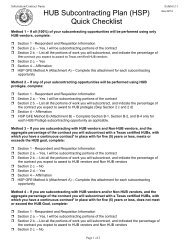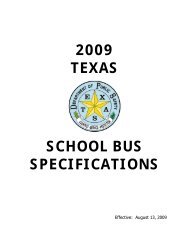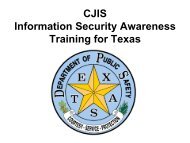Aircraft News (PDF) - Texas Department of Public Safety
Aircraft News (PDF) - Texas Department of Public Safety
Aircraft News (PDF) - Texas Department of Public Safety
Create successful ePaper yourself
Turn your PDF publications into a flip-book with our unique Google optimized e-Paper software.
COURTESY, SERVIC<br />
UNIT PROFILE<br />
By Sgt. Wade Ford and Chief Pilot Jack Reichert, <strong>Texas</strong> Dept. <strong>of</strong> <strong>Public</strong> <strong>Safety</strong><br />
<strong>Aircraft</strong> Section<br />
The <strong>Texas</strong> <strong>Department</strong> <strong>of</strong> <strong>Public</strong><br />
<strong>Safety</strong>’s (DPS’s) <strong>Aircraft</strong> Section was<br />
organized in 1935 with the<br />
primary purpose <strong>of</strong> monitoring<br />
traffic. In 1949, agency leaders determined<br />
a need to transport personnel<br />
more efficiently. The first aircraft, a Navion<br />
single-engine airplane, was purchased,<br />
and one patrolman was transferred in as<br />
the first commissioned pilot. Increased<br />
demands for aerial support prompted the<br />
addition <strong>of</strong> a second pilot in 1952.<br />
In 1967, the DPS acquired its first two<br />
helicopters. Stationed in Dallas and<br />
Austin, the Bell 47G made a positive<br />
impact and proved to be highly effective<br />
for law enforcement missions. These<br />
aircraft were in high demand by ground<br />
personnel, and soon the DPS needed to<br />
upgrade its rotorcraft equipment.<br />
In 1969, the Bell Jet Ranger came into<br />
service for the agency. Seven helicopters<br />
began serving the needs <strong>of</strong> <strong>Texas</strong> law<br />
enforcement in Austin, Dallas, Corpus<br />
Christi, Houston, Lubbock, Midland and<br />
Waco. By 1975, the Jet Ranger was the<br />
workhorse <strong>of</strong> the DPS helicopter fleet.<br />
The requests for SAR missions<br />
increased during the next 12 years, and<br />
with new technology and rising<br />
demands for additional performance,<br />
the department decided to upgrade to<br />
a newer, stronger helicopter. The transition<br />
to replace the Bell Jet Rangers with<br />
AS 350 (A-Star) helicopters began in<br />
1984. The A-Star provided additional<br />
power, lift and incorporated more<br />
police specialized equipment, which<br />
included thermal imaging, nightsun,<br />
GPS, LoJack and ETS tracking equipment,<br />
as well as other options depending<br />
on the age <strong>of</strong> the specific aircraft.<br />
In the summer <strong>of</strong> 2008, the existing<br />
fleet <strong>of</strong> nine A-Stars will be dramatically<br />
increased to include five new AS 350<br />
B2 machines. A special operations helicopter,<br />
an American Eurocopter EC-<br />
145, will be delivered this summer, as<br />
well, bringing the fleet to 14 helicopters.<br />
The Austin-based EC-145 will<br />
assist in SWAT operations, disaster evacuations<br />
and rescues using its hoist and<br />
perform disaster reconnaissance, search<br />
and rescue missions and other special<br />
law enforcement needs. Four new flight<br />
stations are scheduled to open in 2009<br />
along the <strong>Texas</strong>/Mexico border, and<br />
the opening <strong>of</strong> another aviation station<br />
is scheduled to occur in Amarillo.<br />
In addition to its helicopters, the<br />
<strong>Texas</strong> DPS currently operates five<br />
Cessna 206s and two Cessna 210s.<br />
These single-engine aircraft support<br />
ground law enforcement with any<br />
request. The aircraft are stationed across<br />
the regions <strong>of</strong> <strong>Texas</strong> to provide quick<br />
response to the needs <strong>of</strong> local agencies.<br />
To assist in long distance needs, a Gulfstream<br />
Commander 1000 is operated<br />
out <strong>of</strong> Austin. That aircraft is used for<br />
special assignments and the extradition<br />
<strong>of</strong> prisoners in the U. S. In fiscal year<br />
36 AIRBEATMAGAZINE l MayJune l 2008
UNIT PROFILE<br />
E & PROTECTION:<br />
73 Years For<br />
Lone Star State’s<br />
Police <strong>Aircraft</strong> Section<br />
www.alea.org l 37
UNIT PROFILE<br />
<strong>Texas</strong> DPS aircraft are based at the following flight stations:<br />
Austin, Houston, Dallas, Corpus Christi, Waco, San Antonio,<br />
Midland, McAllen and Lubbock. By 2009, bases in Amarillo,<br />
Laredo, Del Rio, Alpine and El Paso will have been added.<br />
2007, 44 percent <strong>of</strong> the flight hours<br />
made with the Commander were<br />
outside <strong>of</strong> <strong>Texas</strong>.<br />
The <strong>Texas</strong> DPS employs over 8,264<br />
employees with over 3,816 commissioned<br />
<strong>of</strong>ficers. It is the largest law enforcement<br />
agency in <strong>Texas</strong> with a responsibility to<br />
over 21 million people in 254 counties.<br />
The geographic area <strong>of</strong> <strong>Texas</strong> covers more<br />
than 250,000 square miles.<br />
Any <strong>Texas</strong> DPS commissioned personnel<br />
is eligible to apply to become a pilot after<br />
four years <strong>of</strong> service if he or she possesses a<br />
private pilot license. Additional training and<br />
ratings are provided on the job. To become<br />
a pilot-in-command <strong>of</strong> a DPS aircraft, a<br />
pilot must accrue a minimum <strong>of</strong> 240 hours<br />
<strong>of</strong> flight time in the specific make and<br />
model aircraft. The goal <strong>of</strong> the aviation unit<br />
is to have all <strong>Texas</strong> DPS pilots rated to fly<br />
both airplanes and helicopters.<br />
Chief Pilot Jack Reichert and Pilot Bill<br />
Nabors head the <strong>Aircraft</strong> Section. Reichert has<br />
26 years in the aviation unit and has accumulated<br />
over 8,500 accident-free flight hours<br />
and 7,000 hours flying DPS aircraft. Assistant<br />
Chief Nabors, also a veteran <strong>of</strong> <strong>Texas</strong> DPS<br />
with 15 years in the Aviation unit, has over<br />
4,000 accident-free DPS flight hours. The<br />
quick growth by the section, both in equipment<br />
and personnel, could not have been<br />
accomplished without the excellent leadership<br />
provided by Reichert and Nabors. Both<br />
men developed and maintained exceptional<br />
working relationships with agency leaders<br />
and members <strong>of</strong> the <strong>Texas</strong> Legislature.<br />
Training and safety are constantly<br />
stressed. All pilots receive training<br />
38 AIRBEATMAGAZINE l MayJune l 2008
Metro Aviation & <strong>Texas</strong> DPS will deliver six new helicopters<br />
to the front line to protect and serve the citizens <strong>of</strong> <strong>Texas</strong>...<br />
...who is your completion partner?<br />
Metro Aviation General Manager, Milton K. Geltz, <strong>Texas</strong> DPS <strong>Safety</strong> & Training<br />
Captain Tim Ochsner, <strong>Texas</strong> DPS Chief Pilot, Jack Reichert and Metro Aviation<br />
Owner Mike Stanberry can tell you about the company’s commitment to<br />
deliver the very best aircraft for your law enforcement missions.<br />
Completions With Your Mission In Mind<br />
I 3<br />
Metro Aviation, Inc. Shreveport, LA 800.467.5529<br />
= Imagination • Innovation • Integration
UNIT PROFILE<br />
TEXAS DPS AIRCRAFT SECTION<br />
2007 Statistics<br />
6,257 -total hours flown<br />
2,686 -total missions<br />
1,787 -criminal investigations<br />
419 -narcotics investigations<br />
738 -suspects located<br />
566 -felony arrests<br />
51 -missing persons located<br />
$3.7 -million stolen property located<br />
$43.7 -million narcotics recovered<br />
throughout the year in various procedures<br />
and emergency operations. Tim Ochsner<br />
is a full-time aircraft training/safety<br />
captain who oversees this need.<br />
In 2006, the <strong>Aircraft</strong> Section received<br />
funds from the Division <strong>of</strong> Emergency<br />
Management to provide all pilots with night<br />
vision goggle (NVG) training. In addition, all<br />
helicopters were equipped with two sets <strong>of</strong><br />
NVGs, and the cockpits were retr<strong>of</strong>itted for<br />
NVG lighting requirements. The NVGs not<br />
only have dramatically increased the safety<br />
<strong>of</strong> the unit, but also have had a direct<br />
impact on pilot confidence and effectiveness<br />
during night operations.<br />
The efficiency and effectiveness in<br />
the cockpit also has been increased with<br />
the addition <strong>of</strong> full-time TFOs. This<br />
allows the unit’s pilots to focus on their<br />
primary responsibility: to fly the aircraft.<br />
All DPS helicopters are equipped with<br />
thermal imaging devices. In the first three<br />
months <strong>of</strong> 2008, in border security operations<br />
alone, this technology has been<br />
instrumental in the apprehension <strong>of</strong> over<br />
350 fugitives.<br />
Maintenance <strong>of</strong> the helicopters and<br />
airplanes is done in Austin by state mechanics<br />
employed by the <strong>Texas</strong> <strong>Department</strong> <strong>of</strong><br />
Transportation. Each aircraft receives an<br />
inspection every 100 hours. The maintenance<br />
on the aircraft is proactive, replacing<br />
worn parts before they become a problem.<br />
Success From the Air<br />
How valuable is an aerial platform in<br />
law enforcement work? For <strong>Texas</strong> DPS, the<br />
results speak volumes.<br />
In 2007, a DPS helicopter was called to<br />
assist ground units searching for an elderly<br />
man suffering from Alzheimer’s disease.<br />
The man had wandered away from a rural<br />
cottage. Searchers on horseback, foot and<br />
4-wheelers had failed to locate the man for<br />
six hours. The helicopter arrived on location,<br />
took on two observers, and located<br />
the lost man on the first pass within the<br />
first minute <strong>of</strong> flight in a dense group <strong>of</strong><br />
trees about 500 yards from the cottage.<br />
The man was unharmed.<br />
But perhaps the most notable rescue<br />
occurred in 2006. A two-year old boy disappeared<br />
from a home in a rural wooded location.<br />
A search was started immediately. Two<br />
days <strong>of</strong> air and ground search yielded no<br />
results. However, on the fourth day, one<br />
determined DPS pilot, along with his tactical<br />
flight <strong>of</strong>ficer (TFO), returned to the search<br />
area on their day <strong>of</strong>f. Flying over a previously<br />
searched area, the flight crew located<br />
the lost boy. The helicopter landed, rescued<br />
the boy, and immediately flew him to a local<br />
hospital. Miraculously, the boy was only<br />
suffering from dehydration and numerous<br />
insect bites. This rescue landed the flight<br />
crew on Good Morning America.<br />
As <strong>Texas</strong> DPS Director Thomas A. Davis,<br />
Jr. once said, “What is the cost <strong>of</strong> a helicopter<br />
when compared to a child’s life?”<br />
With the addition <strong>of</strong> new aircraft,<br />
personnel, high tech equipment and five<br />
new flight stations, the <strong>Texas</strong> DPS <strong>Aircraft</strong><br />
Section will be able to provide faster<br />
response times to pursue criminal activities<br />
and law enforcement requests for<br />
aerial coverage to <strong>Texas</strong> agencies.<br />
40 AIRBEATMAGAZINE l MayJune l 2008





